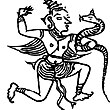
Back سلالة بارامارا Arabic परमार बंस Bihari পরমার রাজবংশ Bengali/Bangla Paramara Catalan Paramara German Dinastía Paramara Spanish سلسله پارامارا Persian Paramara Finnish Dynastie Paramara French परमार वंश Hindi
| House of Paramara | |
|---|---|
 | |
| Parent family | Parmar Rajput clan |
| Country | Kingdom of Malwa |
| Founded | 948 |
| Founder | Siyaka |
| Final ruler | Mahalakadeva |
| Seat | |
| Titles | Emperor of Malwa Maharajadhiraja |
| Dissolution | 1305 |
The Paramara dynasty[a] was the ruling dynasty of Kingdom of Malwa in west-central India between 9th and 14th centuries.[3][4][5] They belonged to the Parmara clan of the Rajputs.[6][7]
The dynasty was established in either the 9th or 10th century, and its early rulers most probably ruled as vassals of the Rashtrakutas of Manyakheta. The earliest extant Paramara inscriptions, issued by the 10th-century ruler Siyaka, have been found in Gujarat. Around 972 CE, Siyaka sacked the Rashtrakuta capital Manyakheta, and established the Paramaras as a sovereign power. By the time of his successor Munja, the Malwa region in present-day Madhya Pradesh had become the core Paramara territory, with Dhara (now Dhar) as their capital. The dynasty reached its zenith under Munja's nephew Bhoja, whose empire extended from Chittor in the north to Konkan in the south, and from the Sabarmati River in the west to Vidisha in the east.

The Paramara power rose and declined several times as a result of their struggles with the Chaulukyas of Gujarat, the Chalukyas of Kalyani, the Kalachuris of Tripuri, Chandelas of Jejakabhukti and other neighbouring kingdoms. The later Paramara rulers moved their capital to Mandapa-Durga (now Mandu) after Dhara was sacked multiple times by their enemies. Mahalakadeva, the last known Paramara king, was defeated and killed by the forces of Alauddin Khalji of Delhi in 1305 CE, although epigraphic evidence suggests that the Paramara rule continued for a few years after his death.
Malwa enjoyed a great level of political and cultural prestige under the Paramaras. The Paramaras were well known for their patronage to Sanskrit poets and scholars, and Bhoja was himself a renowned scholar. Most of the Paramara kings were Shaivites and commissioned several Shiva temples, although they also patronized Jain scholars.
- ^ Schwartzberg, Joseph E. (1978). A Historical atlas of South Asia. Chicago: University of Chicago Press. p. 147, map XIV.3 (a). ISBN 0226742210.
- ^ Benjamin Walker 1995, p. 186.
- ^ Prasad, Ishwari. History of Mediaeval India 800–1700.
In the tenth century the kingdom of Malwa fell into the hands of the Parmar Rajputs, and under their rule it attained to great prominence.
- ^ Austin, Ian. City of Legends The Story of Hyderabad.
Mahmood of Ghazni and Sultan Mohammed Ghori looted the ineffectual Rajput tribes of their gold and jewels. Fortunately, the greatest diamond of all escaped that fate. When the invasions began, it was smuggled out to the Kingdom of Malwa, then ruled by the Parmar Dynasty, becoming their treasured heirloom to be handed down through generations.
- ^ Middleton, John. World Monarchies and Dynasties.
PARAMARA DYNASTY (ca. 820-1235 С.Е.) Rajput rulers of the Indian kingdom of Malwa, who declared independence from neighboring imperial powers and allowed religion, the arts, and learning to flourish. The name Paramara means "slaver of the enemy." The first known king of the dynasty was Upendra (r. ca. 800-818), who was a vassal of the Rastrakuta dy nasty of the Deccan region of India
- ^
- Brajadulal Chattopadhyaya (2006). Studying Early India: Archaeology, Texts and Historical Issues. Anthem. p. 116. ISBN 978-1-84331-132-4.
The period between the seventh and the twelfth century witnessed gradual rise of a number of new royal-lineages in Rajasthan, Gujarat, Madhya Pradesh and Uttar Pradesh, which came to constitute a social-political category known as 'Rajput'. Some of the major lineages were the Pratiharas of Rajasthan, Uttar Pradesh and adjacent areas, the Guhilas and Chahamanas of Rajasthan, the Caulukyas or Solankis of Gujarat and Rajasthan and the Paramaras of Madhya Pradesh and Rajasthan.
- Brajadulal Chattopadhyaya (2006). Studying Early India: Archaeology, Texts and Historical Issues. Anthem. p. 116. ISBN 978-1-84331-132-4.
- ^
- Brajadulal Chattopadhyaya (2006). Studying Early India: Archaeology, Texts and Historical Issues. Anthem. p. 116. ISBN 978-1-84331-132-4.
The period between the seventh and the twelfth century witnessed gradual rise of a number of new royal-lineages in Rajasthan, Gujarat, Madhya Pradesh and Uttar Pradesh, which came to constitute a social-political category known as 'Rajput'. Some of the major lineages were the Pratiharas of Rajasthan, Uttar Pradesh and adjacent areas, the Guhilas and Chahamanas of Rajasthan, the Caulukyas or Solankis of Gujarat and Rajasthan and the Paramaras of Madhya Pradesh and Rajasthan.
- Brajadulal Chattopadhyaya (2006). Studying Early India: Archaeology, Texts and Historical Issues. Anthem. p. 116. ISBN 978-1-84331-132-4.
- ^ Schwartzberg, Joseph E. (1978). A Historical atlas of South Asia. Chicago: University of Chicago Press. p. 147, map XIV.3 (a). ISBN 0226742210.
Cite error: There are <ref group=lower-alpha> tags or {{efn}} templates on this page, but the references will not show without a {{reflist|group=lower-alpha}} template or {{notelist}} template (see the help page).